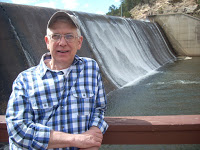“Peter, Peter pumpkin eater
Had a wife but couldn’t keep her,
Put her in a pumpkin shell
And there he …”
uh, uh, something
“… very well.”
Two syllables, what was the word? words? Sure.
“Kept her very well.”
These days I still recall several Mother Goose rhymes because some of the names like Peter are answers for clues in one of the crossword puzzles I work each day. They’re stored deep in an obscure folder in my mind and reside in the culture although we rarely think of them as important except for children’s language development.
“There was a crooked man and he went a crooked mile,
And found a crooked sixpence against a crooked stile;
He had a crooked cat which caught a crooked mouse
And they all lived together in a crooked little house.”
I recall one of my grade school teachers explaining sixpence and stile just like my college literature professor years later explained odd words and expressions in Shakespeare and John Milton. So these rhymes were an introduction not only to poetry and vocabulary but also to literary criticism.
Most important for me, though, was that Mother played the role of Mother Goose in our house. She introduced us kids to the large volume that had a picture of a bespectacled and bonnet-clad Mother Goose on its cover. From it she read aloud to us endlessly. She quoted even more poetry from memory, she told stories of the family, she researched and relayed her findings about Gypsies, about cooking, about Girl Scouts, about history, and sometimes about movie stars. Mother introduced us to literature: children’s literature, classic comic books, tongue twisters, and so much more. She danced with her cats as well as with us. She entertained. She played. She challenged us to look. She wanted us to engage in life. And, like those of the literary Mother Goose, some of her tales were tricky. We had to figure out just what they were about. Of course, in the meantime, there was always the rhythm, the characters, the word play, and her charm. She never let the characters wander too far away from our conversation. She’d suggest the spider walking across the kitchen floor was just like one that so frightened Miss Muffett, point out Peter Rabbit in her mother’s large garden, or identify me with the little boy Georgy Porgy who so liked eating his puddin’ and pie. She made literature live for her children.
Father Goose lived at our house too. He read to us, usually from the Eggermeier’s Bible story book. He pronounced each character and place name correctly having listened to countless sermons from educated preachers and consistently following the code of his self-pronouncing King James Version Bible. He played the piano to our delight. He sang and taught us to sing. He also entertained, occasionally doing an old high school cheer—he had been a cheerleader—or dancing to an old jazz tune he put on the record player—he’d played for years in a dance band. He employed and discussed difficult words and taught us generosity with vocabulary as well as with other resources.
And we, too, all lived together in a little Cape Cod house where the children’s world of old Britain was brought close to us in our Kansas town. So was the world of the ancient Hebrews, Egyptians, and Sumerians. It’s no wonder I started devouring book after book of historical fiction on my own beginning in the eighth grade. And thanks to the creativity of my mother and father and of the effectiveness of the education I received, Mother Goose stills reigns supreme in my world of literary fantasy.
Denver, 2012
About the Author
Phillip Hoyle lives in Denver and spends his time writing, painting, giving massages, and socializing. His massage practice funds his other activities that keep him busy with groups of writers and artists, and folk with pains. Following thirty-two years in church work, he now focuses on creating beauty and ministering to the clients in his practice. He volunteers at The Center leading “Telling Your Story.”
He also blogs at artandmorebyphilhoyle.blogspot.com
